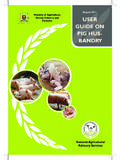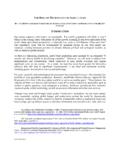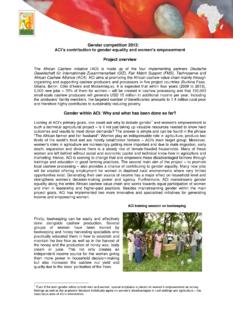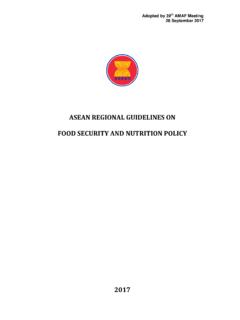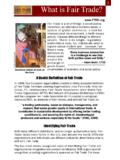Transcription of BANANA PRODUCTION GUIDE a) Importance of …
1 1 BANANA PRODUCTION GUIDE a) Importance of BANANA The BANANA is an important economic resource for rural farmers in Uganda. With a total annual PRODUCTION estimated at about 10MT, the crop ranks high among enterprises that support livelihoods of smallholder poor rural farming communities. About 75% of Ugandan farmers grow the crop on million hectares of land, an estimated 38% of arable land under use. Domestic per capita consumption of bananas in Uganda is estimated between 220-460Kg, the largest in the world. Farming communities in Uganda have consistently ranked the BANANA crop as their number one because it is an all-year-round fruiting plant, a character that places it above others as a food and income security crop. The BANANA is a perennial crop, with a root net work and broad leaves which maintain soil structure and provides a soil cover throughout the year hence reducing land degradation.
2 This attribute makes the BANANA crop an important component in environmental management. BANANA has a multiplicity of uses including food, beverages (soft and alcoholic), snacks, feed, industrial spirits, a number of crafts and medicinal potency. Studies have shown that the BANANA is the cheapest carbohydrate to produce and they are able to grow in a wide range of environments and farming systems including pure stand, intercropping, and livestock/crop farming systems. Uganda s BANANA market potential within and outside the region is grossly underutilized. Only of the market potential is utilized b) Ecological requirements i) Soil: Deep, fertile soils are essential but free draining soil capable of retaining reasonable moisture is suitable. ii) Rainfall Best areas of high to medium rainfall 9above 800 mm) with moderate temperatures.
3 Iii) Altitude: both low and high altitudes are favourable Wind shelter: BANANA should be planted in blocks rather than in strips so that the plants give each other self protection since they are highly susceptible to wind damage. c) Types of bananas and examples of their respective varieties i) Cooking BANANA : Nakabululu, Muvubo ii) Beer BANANA : Kiasubi Kayinja iii) Roasting BANANA : Gonja. 2 iv) Dessert BANANA : Bogoya, Ndizi (apple BANANA ). d) Propagation Sword suckers as shown in figure 1 are the best to use. The best size for suckers is 1-11/2 meters. Suckers should be taken from vigorous healthy plants. : Sword sucker e) Cultural practices i) Planting Best at the beginning of the main rains. Holes should be at least 60 cm (2 ft) in diameter and 60 cm (2 ft) deep. Half fill the top soil mixed with rotted manure before putting in to the planting hole.
4 A cover crop beans, groundnuts should be inter-planted. It is advisable to plant at the beginning or during the main rain season for proper establishment and subsequent PRODUCTION . ii) Spacing and plant population Spacing varies with type of bananas. Tall types of Bogoya are widely spaced and short ones like Nakytengu are closely spaced. On average, 3 spacing is 3m x 3m (10ft x 10 ft); ranging from m to m between the holes giving a plant population of 750 900 per hectare ha. iii) Weed control Weed infestation can cause a drop in BANANA yield. Therefore weeds must be controlled either by mechanical weeding or by herbicides Grammaxone. For a mature established field mulching with coffee husks, elephant grass or other dry seedless grasses is a recommended practice against weeds. iv) Soil erosion control On sloping land especially where mulching is inadequate, put in bands stabilized with elephant grass.
5 V) Desuckering Leave 3-5 main stem of varying ages per stool (see figure 2). This arrangement gives continuous crop throughout the year. The fewer the number of stems the bigger the size of bunches. : Desuckered BANANA stool vi) Fertilizer application For proper PRODUCTION , a good supply of nutrients is needed. The crop will benefit from farm yard manure (FYM) if available or a dressing of 4 500 gm of signle superphosphate, (SSP) 500 gm muriate of potash (MOP) and 500 gm of calcium-ammonium-nitrate (CAN) at planting. vii) Insect pests and disease control Pests: Most important BANANA insect pests include: This is the most damaging insect pest of bananas in Uganda, and East Africa as a whole. Damage is most in neglected plots. The weevil lives, feeds and breeds in pseudostems for periods up to two years.
6 It lays eggs against the sides of the stems. After hatching the larva burrow into pseudostems thereby weakening them and making them liable to wind damage. Methods of control include: - Selection of planting material from uninfected stools; - Dipping planting material in dieldrin solution; - Chopping up old stems longitudinally and covering their bases with soil and encouraging healthy growth by pruning/desuckering and mulching; - Spreading dieldrin dust around infected stools; - Laying traps of pieces of stem which have been cut in half longitudinally and treated with dieldrin dust. - Laying traps of pieces of stem which have been cut in half longitudinally and treated with dieldrin dust. Nematodes These have been recorded as doing mush damage in several parts of Uganda BANANA growing areas. Control is by dipping planting material into a suitable nematicide.
7 Diseases: Serious BANANA diseases include: Panama disease, cigar end rot, sigatoka and BANANA bacterial wilt. Panama disease 5 This is a fungus disease which has caused widespread damage in the former Ankole district of Uganda. The symptoms include: - yellowing of lower leaves which later hang downwards; - a purple discoloration of the vascular tissue inside the stems and rhizomes. Control: is by use of resistant BANANA varieties, for example some of the cooking various and dwarf Cavendish. Planting material should not be taken from an infected area to an uninfected one. Cigar end rot This is also a fungus disease which makes the tips of fruits ( BANANA fingers) look like the ash on the end of a cigar, hence the name. Main damage occurs in areas which are minimally suitable for BANANA cultivation. The disease can be controlled by removing the ends of the inflorescence beyond the developing fruits.
8 BANANA bacterial Wilt Fig. 3: BBW infected BANANA plant 6 BANANA bacterial wilt (BBW) is a bacterial disease. All BANANA varieties are susceptible to BBW. It is very destructive with incidence of 70-80% in many plantations causing yield losses of 90%. Symptoms: o Dull yellow wilting leaves o Fruits ripen unevenly when bunch is still young o Yellow puss oozes from cut stem o Fruits show brown stains when cut See Fig. 3. Spread o By insects like bees o Through garden tools o Use of infected planting materials Control o Remove male bud with a forked stick immediately last cluster has formed o Use clean planting materials o Disinfect tools with fire or jik o Cut and heap or burry infected plants. viii) Staking BANANA pseudostems are likely to break under the weight of heavy bunch. Thus, forked poles should often be used to keep the stems upright, as demonstrated in figure 4.
9 7 : Properly staked BANANA f) Harvesting, post-harvest handling and yield The fruit is cut down from the BANANA tree when mature. The color of the fruits when ripe varies among varieties. For some varieties especially the cooking ones, the color remains green but for the beer and desert varieties the color turns yellow. When bunches are harvested for sale, care should be taken to prevent the fruits from being bruised. Average yields of bananas ar 1000 1200 bunches/ha/annum under medium husbandry practices and 1250 bunches under excellent husbandry practices. Bananas cannot be stored for long as they get ripe and rot after a short time. After harvesting they must be marketed quickly. They must also be protected as shown in Fig. 5 from direct sun which hastens the ripening process. 8 Fig. 5: Protecting fresh BANANA from the sun
